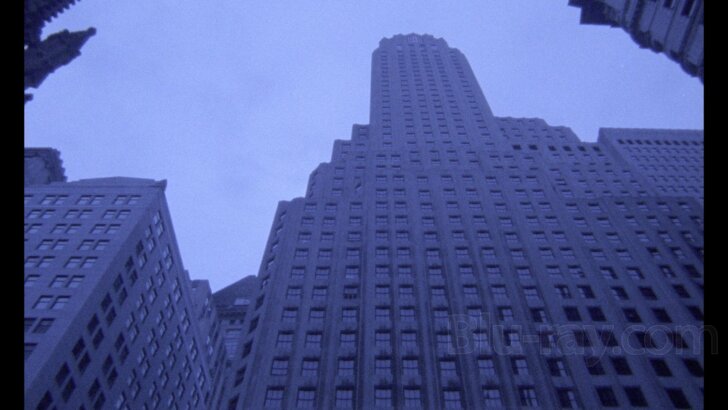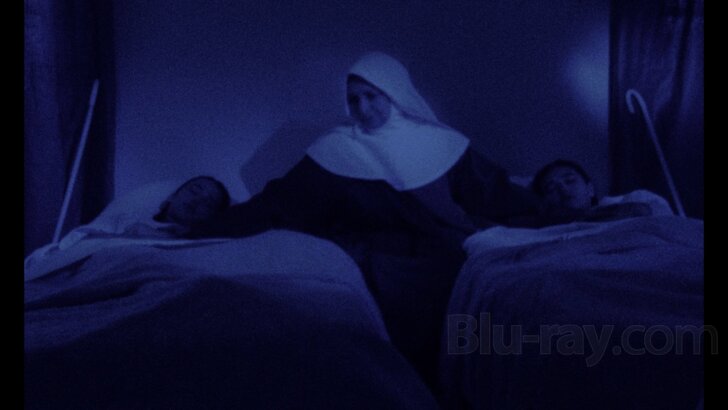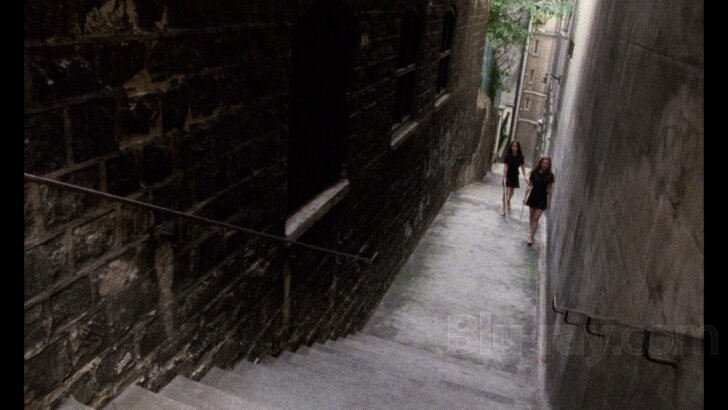Two Orphan Vampires 4K Blu-ray Movie
HomeTwo Orphan Vampires 4K Blu-ray Movie 
Les deux orphelines vampires | Indicator Series | Limited Edition / 4K Ultra HD + Blu-rayPowerhouse Films | 1997 | 107 min | Not rated | May 09, 2023

Movie rating
6.3 | / 10 |
Blu-ray rating
| Users | 4.5 | |
| Reviewer | 4.0 | |
| Overall | 4.0 |
Overview
Two Orphan Vampires 4K (1997)
The film is the story of two teenage girls, Louise and Henriette, who have grown up orphaned and are believed to be blind. While it is true that they cannot see during the day, Louise and Henriette are given the power of vision at night, when they hunt their prey.
Starring: Alexandra Pic, Isabelle Teboul, Natalie Perrey, Gudule, Bernard CharnacéDirector: Jean Rollin
| Horror | 100% |
| Foreign | 79% |
| Erotic | 35% |
Specifications
Video
Video codec: HEVC / H.265
Video resolution: 4K (2160p)
Aspect ratio: 1.66:1
Original aspect ratio: 1.85:1
Audio
French: LPCM Mono (48kHz, 24-bit)
English: LPCM Mono (48kHz, 24-bit)
Subtitles
English, English SDH
Discs
Blu-ray Disc
Single disc (1 BD)
4K Ultra HD
Playback
Region A (B, C untested)
Review
Rating summary
| Movie | 3.5 | |
| Video | 0.0 | |
| Audio | 5.0 | |
| Extras | 4.0 | |
| Overall | 4.0 |
Two Orphan Vampires 4K Blu-ray Movie Review
Reviewed by Dr. Svet Atanasov May 6, 2023Jean Rollin's "Two Orphan Vampires" a.k.a. "Les deux orphelines vampires" (1997) arrives on 4K Blu-ray courtesy of Indicator/Powerhouse Films. The supplemental features on the release include new audio commentary by critics and authors David Flint and Adrian J. Smith; archival programs with actresses Alexandra Pic and Isabelle Teboul; vintage promotional and production materials; and more. In French or English, with optional English and English SDH subtitles for the main feature. Region-Free.

Blue world
In the 1970s, Jean Rollin perfected his style and legitimized that very fluid place his films loved to visit. I will call this place The Other Side and do my best to provide a short but accurate description of it because the only way to fully grasp what happens in Rollin’s films is to know why it kept reemerging in them.
Rollin conceived and kept revisiting The Other Side for two simple reasons. Rollin was fascinated by the classic cycle of existence but suspicious of its definitive nature, which is why vampirism became a key theme in his films. In The Other Side, Rollin speculated that death, the final phase of the classic cycle of existence, could have been mischaracterized and began manipulating its definition. In Rollin’s earliest films, the manipulation was often done with an unmissable dark sense of humor that made his blending of mysticism and horror incredibly atmospheric but frequently confusing to those that wanted to describe them as conventional genre projects. In Rollin’s latter films, the manipulation was almost always an extension of something else -- an unorthodox exploration of female elegance, beauty, and psychology, as understood by Rollin.
Also during the 1970s, Rollin realized that in The Other Side he was a master of his craft. Unsurprisingly, the more time Rollin spent there with his films, the more comfortable he became experimenting with different, often quite unusual material. This is the reason even the least impressive of Rollin’s films recreate The Other Side just as well as his most impressive films do -- they all easily transition to The Other Side but the quality of Rollin’s experiments there varies. (For what it’s worth, Jess Franco’s films visited a place that was very, very similar to The Other Side and his experiments there produced the same hits and misses. Franco was simply a far more productive director, so the spikes and drops in quality his films exhibited were much more dramatic).
The Other Side is unaffected by the passage of time. It has a unique and everlasting atmosphere that is far more important than its appearance. It is why Rollin’s films from the 1970s and 1990s, for instance, are very easy to mix up. Also, in The Other Side, a very particular kind of music has an irreplaceable role. This music is unaffected by the passage of time, too.
Rollin made Two Orphan Vampires in the late 1990s but this is a film that easily could have emerged from the 1970s. It effortlessly transitions to The Other Side and Rollin immediately initiates his favorite -- and of course by mainstream standards quite unorthodox -- experimental work. It follows closely two teenage girls that are blind during the day but regain their vision at night when they feel fully alive. They spend their time moving between two different worlds -- one in which they gravitate around normal people that are unaware of the true nature of their condition, and one in which they are drawn to spooky creatures that prefer to hide in the thickest shadows of the night. When the sun goes down, the teenage girls roam the streets of Paris and find strangers that supply them with the fresh blood their tiny bodies require.
If you approach Two Orphan Vampires expecting it to be a conventional film about vampirism, it is practically guaranteed that your experience with it will be underwhelming. It does have vampires and rituals you would associate with vampirism, but this film is conceived in much the same way Wings of Desire is. Indeed, it shifts the angle from which you register reality and rationalize behavior and relationships that are possible in it, but instead of revealing that it is populated by angels, it exposes the presence of spooky creatures of the night.
It is easy to tell that Rollin did not have a big budget to work with because much of the footage in The Orphan Vampires has a very modest, often even minimalistic appearance. However, the effective management of filtered blue light and shadows combined with the tremendous psychedelic tunes that often complement the visuals produce a tremendous atmosphere. This is hardly surprising. It is the most attractive quality of The Other Side.
Two Orphan Vampires 4K Blu-ray Movie, Video Quality 

The 4K Blu-ray release of Two Orphan Vampires does not have a Blu-ray copy of the film. There is a separate Blu-ray release of the film, which is listed here. I have copies of both and can confirm that they are Region-Free.
I have included screencaptures from the two releases. Please note that the screencaptures from the 4K Blu-ray are downscaled to 1080p. Therefore, they do not accurately reflect the quality of the 4K content on the 4K Blu-ray disc, including the actual color values of this content.
Screencaptures #1-22 are from the Blu-ray.
Screencaptures #26-30 are from the 4K Blu-ray.
The 4K Blu-ray and Blu-ray releases introduce a brand new 4K makeover of Two Orphan Vampires that might be the best presentation of a Jean Rollin film to date. I have acquired all North American Blu-ray releases of Rollin films and can categorically state that there isn't another presentation quite like it.
I viewed the entire 4K makeover in native 4K and in 1080p. In native 4K, I chose the HDR grade and then did several comparisons with the previous release of the film from the Redemption label. Before I comment on the quality of the presentation, I must point out that I disagree with Casey Broadwater's take on the previous presentation of the film. I think that it is very convincing and with very consistent organic qualities. It just isn't quite as healthy as the new 4K makeover.
In native 4K, all visuals boast excellent delineation, clarity, and depth. A lot of the darker areas where filters/color light are used look particularly good now because the higher resolution and expanded dynamic range of the visuals handle many delicate nuances exceptionally well. Also, even though shadow nuances were very nice on the previous release, here they look more convincing. Grain exposure varies, but all fluctuations are introduced by the original cinematography. Image stability is excellent. In native 4K and 1080p, the visuals boast wonderful fluidity, so frame movement looks very natural and cinematic. On the previous release, some small bumps can be spotted.
I was surprised to discover that color balance is not one hundred percent identical on the 4K Blu-ray and Blu-ray. For some reason, on the 4K Blu-ray, blue primaries and nuances occasionally begin to move toward turquoise. (Obviously, the HDR/Dolby Vision grade expands the color gamut, but there is more happening). The difference is not significant, but folks that have access to the 4K Blu-ray and Blu-ray releases will notice the shift. Even though our downscaled screencaptures from the 4K Blu-ray release do not accurately reproduce the color values of the 4K content, you can get a basic idea of what type of discrepancies emerge if you compare this screencapture from the 4K Blu-ray and this screencapture from the Blu-ray. While I like how some darker areas look on the 4K Blu-ray a lot, I think that the overall color balance and temperature of the 1080p presentation are slightly better. The entire film looks spotless.
Two Orphan Vampires 4K Blu-ray Movie, Audio Quality 

There are two standard audio tracks on this 4K Blu-ray release: French LPCM 1.0 and English LPCM 1.0. Optional English subtitles are provided for the French track, and optional English SDH subtitles are provided for the English track.
The original audio track for Two Ophan Vampires is the French track. The English track is a pretty exotic dub track that does not synch well with the atmosphere of the film. The lossless French track is terrific. I think that the music sounds quite incredible and in many areas becomes far more effective than the visuals. The audio is nicely rounded, stable, and very healthy. The English translation is excellent.
Two Orphan Vampires 4K Blu-ray Movie, Special Features and Extras 

- Memories of a Blue World - this documentary explores the genesis and production of Two Oprhan Vampires as well as the film's placement in Jean Rollin's body of work. Included in it are clips from interviews with assistant director Jean-Noel Delamarre, actress Isabelle Teboul, actor Bernard Charnace, and actress and production assistant Veronique Djaouit Travers, among others. The program was produced by Daniel Gouyette. In French, with English subtitles. (43 min).
- Jean Rollin: Infinite Dreams - in this archival program, Jean Rollin discusses his fascination with surrealism and some of the specific ways in which it was reflected through his films. Rollin also addresses the evolution of his style. In French, with English subtitles. (36 min).
- Alexandra Pic: Bounded by Blood - in this archival program, actress Alexandra Pic recalls her initial encounter with Jean Rollin and involvement with Two Orphan Vampires. In French, with English subtitles. (14 min).
- Isabelle Teboul: Eyesight to the Blind - in this archival program, actress Isabelle Teboul recalls how she was cast to play her character in Two Orphan Vampires and what it was like to work with Jean Rollin. There are some particularly interesting comments about the nude footage with the two vampires and the trip to New York City where a small portion of the film was shot. In French, with English subtitles. (11 min).
- The Smoking Vampires - in this archival program, Alexandra Pic and Isabelle Teboul visit an area of the cemetery in Paris where a key sequence in Two Orphan Vampires was shot. The former quickly addresses her smoking habit. In French, with English subtitles. (4 min).
- Livres de sang - in this archival program, Jean Rollin quickly discusses a few of his books, one of which is the first French edition of Two Orphan Vampires. In English. (8 min).
- Trailer - presented here is a vintage trailer for Two Orphan Vampires. In French, with English subtitles. (2 min).
- Image Gallery -
1. Production and Publicity.
2. New York Location Photography.
- Commentary - this exclusive new commentary was recorded by critics and authors David Flint and Adrian J. Smith. The two commentators discuss in great detail the style and personality of Two Orphan Vampires, its placements among the other vampire films Jean Rollin made, some of the genre overlapping that occurs in these films, and the evolution of the director's cinematic style.
- Book - a limited edition exclusive 80-page book with a new essay by David Hinds, an archival introduction by Jean Rollin, an archival interview with the director by Peter Blumenstock, an archival interview with actor Marie-Pierre Castel, Andy Votel on Acanthus, the mysterious group behind the film's soundtrack, an overview of contemporary critical responses, as well as technical credits.
Two Orphan Vampires 4K Blu-ray Movie, Overall Score and Recommendation 

If you try to understand the cinematic world of Jean Rollin only by viewing archival content with the director and various programs where his work is deconstructed by prominent critics, it is practically guaranteed that you will be introduced to a mainstream image of it that is quite misleading. For example, there is an interesting archival program with Rollin on this release in which he describes himself as a devout cinematic surrealist, but the truth is that he was an unconventional cinematic improvisator like Jess Franco. (It is precisely why he did adult films, too). Also, Rollin did some quite fascinating things while questioning the classic cycle of existence and exploring female elegance, beauty, and psychology, so the majority of his films are very intimate projects. Two Orphan Vampires is not regarded as one of Rollin's best films, but I think that it produces the same tremendous atmosphere that makes all of his films unique and enjoyable. This 4K Blu-ray release is sourced from a very fine new 4K master, but does not have a Blu-ray copy of the film. If you need a Blu-ray copy, you will have to pick up this release. HIGHLY RECOMMENDED.
Other editions
Two Orphan Vampires: Other Editions

Two Orphan Vampires
Les deux orphelines vampires
1997

Two Orphan Vampires
Les deux orphelines vampires | Indicator Series | Limited Edition
1997
Similar titles
Similar titles you might also like

Fascination 4K
Limited Edition | Indicator Series
1979

The Shiver of the Vampires
Le frisson des vampires / Strange Things Happen at Night | Indicator Series | Limited Edition
1971

The Rape of the Vampire 4K
Le viol du vampire | Indicator Series | Limited Edition
1968

Dracula's Fiancée
La fiancée de Dracula
2002

The Demoniacs
Les démoniaques | Limited Edition | Indicator Series
1974

The Night of the Hunted
La nuit des traquées | Indicator Series | Limited Edition
1980

Lips of Blood 4K
Lèvres de sang | Limited Edition | Indicator Series
1975

Vampyros Lesbos
Special 2-Disc Limited Edition
1971

Daughter of Dracula
La fille de Dracula
1972

Requiem for a Vampire
Caged Virgins / Vierges et vampires / Requiem pour un vampire
1971-1973

The Iron Rose
La rose de fer
1973

Lake of Dracula
呪いの館 血を吸う眼 / Noroi no yakata: Chi o suu me
1971

The Vampire Doll
Chi o suu ningyô
1970

The Werewolf Versus the Vampire Woman 4K
Limited Edition | La noche de Walpurgis / Werewolf Shadow / Werewolf and the Vampire Woman | Slipcover in Original Pressing
1971

The Nude Vampire 4K
La vampire nue | Limited Edition | Indicator Series
1970

Devil's Kiss
La perversa caricia de Satán
1976

Black Sabbath
AIP Cut | 60th Anniversary
1963

Black Sunday
AIP Cut
1960

The Vampire and the Ballerina
L'amante del vampiro
1960

Night of the Werewolf
El retorno del hombre lobo
1981